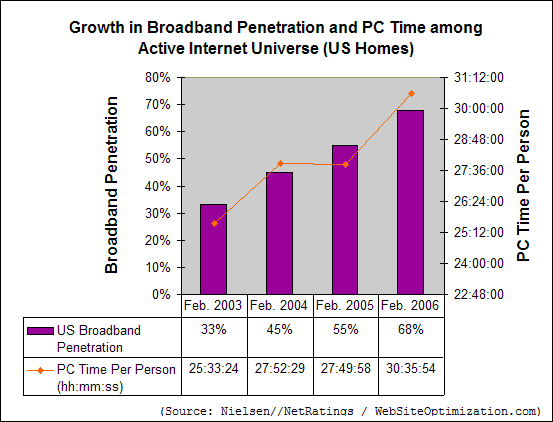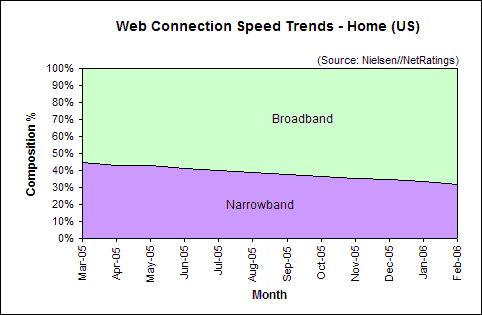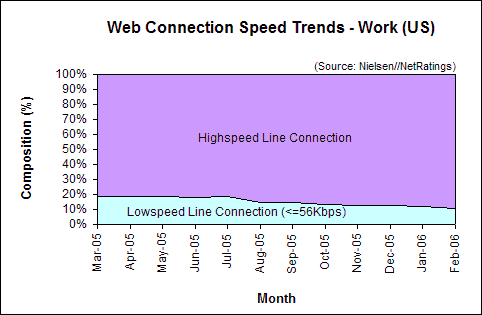Podcasting is taking off, according to recent data from Nielsen//NetRatings and Apple. Unique users of Apple’s iTunes player passed QuickTime in mid-2005, and at current growth rates iTunes should pass RealPlayer by mid-2006. People are tuning in over twice as long with iTunes than with RealPlayer or Windows Media Player. US broadband penetration jumped 1.33 percentage points in February 2006 to 68% among active Internet users. At current growth rates broadband penetration should break 70% in April of 2006.
Apple’s iTunes Player Climbs Streaming Media Charts
Despite its late entry into the streaming media arena, Apple’s iTunes player is climbing the charts faster than its competitors. iTunes has eclipsed QuickTime in unique users, and should pass RealPlayer in mid-2006 at current growth rates. Only Microsoft’s Windows Media Player will have more unique users than iTunes. In mid-2006 Microsoft’s player will have about 80 million unique users, while iTunes will have just under 30 million (see Figure 1 and Table 1).
Streaming Media Players – Unique User Trends
Figure 1: Streaming Media Players – Unique User Trends
Source: Nielsen//NetRatings
| Internet Application | Jan-03 | Jan-04 | Jan-05 | Jan-06 |
|---|---|---|---|---|
| Windows Media Player | 40,246 | 51,056 | 60,782 | 71,112 |
| RealPlayer | 26,710 | 28,593 | 28,182 | 28,687 |
| iTunes | 1,118 | 5,370 | 18,568 | |
| Apple QuickTime | 14,960 | 15,458 | 13,136 | 12,817 |
iTunes is used over twice as long as its nearest rival RealPlayer (111 minutes versus 46.4 minutes per person, or 2.4 times as long). Besides iTunes, RealPlayer is the only other player surveyed to show growth in usage over the last three years. QuickTime and Windows Media Player are losing mindshare among users (see Figure 2).
Streaming Media Player Time per Person Trends
Figure 2: Streaming Media Player Time per Person Trends
Source: Nielsen//NetRatings
PC Time Tracks Broadband Growth in US
As broadband penetration becomes more widespread, people are spending more time on their computers. Since February 2003, the average PC time per person among active Web users has increased by about five hours from 25 and a half hours a month to 30 and a half hours a month (see Figure 3). During the same time period broadband penetration has increased from 33% to 68% among active Internet users. “Faster response times result in more flow and less frustration, hooking users to stay online longer with their computers,” said Andy King, President of Website Optimization, LLC.
PC Time Tracks Broadband Growth
Figure 3: PC Time Tracks Broadband Growth
Source: Nielsen//NetRatings
Home Connectivity in the US
US broadband penetration grew to 68% in February 2006. Narrowband users (56Kbps or less) now comprise 32% of active Internet users, down 1.33 percentage points from 33.33% in January (see Figure 4).
Web Connection Speed Trends – Home Users (US)
Figure 4: Web Connection Speed Trends – Home Users (US)
Source: Nielsen//NetRatings
Broadband Growth Trends in the US
In February 2006, broadband penetration in US homes rose 1.33 percentage points to 68% up from 66.67% in January. This increase of 1.33 points is higher than the average increase in broadband of 1.13 points per month over the last six months. At the current growth rate, broadband penetration among active Internet users in US homes should break 70% by April of 2006 (see Figure 5).
Broadband Adoption Growth Trend – Home Users (US)
Figure 5: Broadband Adoption Growth Trend – Home Users (US)
Extrapolated from Nielsen//NetRatings data
Work Connectivity
Most workers in the US enjoy high-speed connections to the Internet. Most use a high-speed line such as a T1 connection, and share bandwidth between computers connected to an Ethernet network. The speed of each connection decreases as more employees hook up to the LAN. As of February of 2006, of those connected to the Internet, 89.07% of US users at work enjoy a high-speed connection, up 1.09 percentage points from the 87.98% share in January. At work, 10.93% connect at 56Kbps or less (see Figure 6).
Web Connection Speed Trends – Work Users (US)
Figure 6: Web Connection Speed Trends – Work Users (US)
Source: Nielsen//NetRatings
Further Reading
- Apple iTunes – 1 Billion Songs
- Apple reported that they sold their 1 billionth song to a man from West Bloomfield, Michigan in late February. Apple also announced that they’ve sold 15 million videos at the iTunes Music Store. Apple Computer, Feb. 23, 2006.
- Flow in Web Design
- Flow is the process of optimal experience characterized by intense concentration, a limited stimulus field, and loss of self. Fast response times and immediate feedback with few distractions can enable a flow state in your users. Chapter 2 summary of Speed Up Your Site: Web Site Optimization, Andy King New Riders Publishing 2003.
- Internet Videos Spawn Performance Anxiety
- As higher bandwidth content streams to more bandwidth-hungry users quality of service can suffer. Some industry experts are wondering if the Net can scale to handle the load. WebSiteOptimization.com’s February 2006 Bandwidth Report.
- iTunes Player
- The Apple iTunes player is used over twice as much as its nearest rivals, RealPlayer and Windows Media Player.
- Music hath charms for some workers – others it annoys
- iPods have become so popular at the office, they are starting to annoy some coworkers. Includes iPod sales data from Apple SEC filings for 2003 (0.9 million), 2004 (4.4 million), and 2005 (22.5 million). USA Today, March 23, 2006.
- Nielsen//NetRatings
- Provided the streaming media player and US broadband data for the Bandwidth Report.
- Two-thirds of Active U.S. Web Population Using Broadband, up 28 percent year-over-year to an all-time high (PDF)
- Nielsen//NetRatings reports that number of active home broadband users increased 28 percent year-over-year, from 74.3 million in February 2005 to 95.5 million in February 2006. Broadband penetration among active home users grew 13 percentage points from February 2005 (55%) to February 2006 (68%). Nielsen//NetRatings, March 14, 2006.
*Note that Nielsen//NetRatings NetSpeed report determines the connection speeds of the Digital Media Universe, which combines Web traffic, Internet applications and proprietary channels. The streaming media player data used in this report was from NetRatings’ NetView service, which pulls usage from the same panel as the NetSpeed data. The NetView service is based on Nielsen’s RDD panel of about 30,000 home/work panelists in the U.S.
The Bandwidth Report is featured monthly on URLwire – news of useful and unique web content since 1994.






